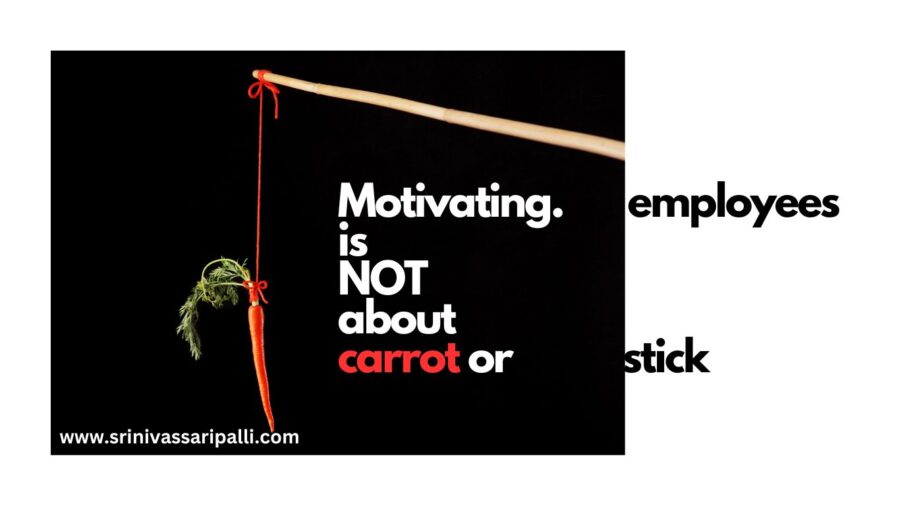Employee motivation is a complex and dynamic aspect of organizational management that extends beyond the traditional paradigms of rewards and punishments. Motivating Employees Is Not About Carrots or Sticks- While carrots and sticks have been traditional tools for motivating employees, contemporary workplaces demand a more nuanced and sophisticated approach. This blog delves into the intricacies of employee motivation, exploring the limitations of conventional methods and advocating for a more holistic and empathetic approach that considers the diverse needs and aspirations of today’s workforce.
Section 1: The Evolution of Employee Motivation
Employee motivation has a rich historical context, shaped by various theories and paradigms that have evolved over time. This section aims to provide an overview of the historical perspectives on motivation and trace the changes in the landscape of work that have influenced how organizations approach the motivation of their workforce.
- Historical Perspectives on Motivation:
- Origins of the Carrot-and-Stick Approach: The carrot-and-stick approach, rooted in behaviorist psychology, originated as a way to influence human behavior through rewards (carrots) and punishments (sticks). This section will explore the historical context in which this method gained prominence and its initial success in shaping employee behavior.
- Influential Theories: Beyond the carrot-and-stick approach, several influential psychological theories have contributed to our understanding of motivation. This includes Maslow’s Hierarchy of Needs, which suggests that individuals are motivated by a hierarchy of needs ranging from basic survival to self-actualization, and Herzberg’s Two-Factor Theory, which distinguishes between hygiene factors (job context) and motivators (job content). Exploring these theories provides a foundation for understanding the complexity of human motivation.
- The Changing Landscape of Work:
- Impact of Technology and Globalization: The advent of technology and globalization has transformed the nature of work. Traditional industrial economies have given way to knowledge-based economies, altering the skills required and reshaping the expectations of employees. This subsection will discuss how these changes impact the motivational factors that are relevant in contemporary workplaces.
- Rise of Intrinsic Motivation: With the shift towards knowledge-based work, the significance of intrinsic motivation—motivation that comes from within, driven by a sense of purpose, autonomy, and mastery—has gained prominence. This part of the section will delve into the changing dynamics of motivation, emphasizing the need to move beyond external rewards and punishments.
Understanding the historical context and the evolution of theories provides a foundation for critically examining current approaches to employee motivation. By exploring the roots of traditional methods and recognizing the changing nature of work, organizations can better adapt their strategies to meet the diverse needs of today’s workforce.
Section 2: The Shortcomings of Carrots and Sticks
While the carrot-and-stick approach has been a longstanding method for motivating employees, this section aims to shed light on its limitations. By delving into the concepts of intrinsic and extrinsic motivation, as well as psychological phenomena like the overjustification effect, this section underscores the need for a more nuanced and comprehensive understanding of what drives employee performance.
- Intrinsic vs. Extrinsic Motivation:
- Fundamental Difference: This part of the section focuses on distinguishing between intrinsic and extrinsic motivation. Intrinsic motivation is the internal desire to engage in an activity for its own sake, deriving satisfaction from the activity itself. Extrinsic motivation, on the other hand, involves external factors like rewards or punishments influencing behavior. Discussing these fundamental differences sets the stage for evaluating the efficacy of each in the workplace.
- The Limits of Extrinsic Motivation: Understanding the limitations of relying solely on extrinsic motivators, such as bonuses or promotions, is crucial. External rewards may produce short-term compliance, but they often fall short in fostering sustained commitment and passion among employees.
- The Overjustification Effect:
- Undermining Intrinsic Motivation: The overjustification effect occurs when external rewards diminish an individual’s intrinsic motivation to perform a task. This part of the section explores the psychological mechanisms behind this phenomenon, emphasizing how an excessive focus on rewards can lead to a reduction in the intrinsic joy or satisfaction derived from the work itself.
- Real-World Examples: Incorporating real-world examples and case studies helps illustrate the overjustification effect in practical settings. Instances where the introduction of rewards led to a decline in intrinsic motivation provide tangible evidence of the phenomenon’s relevance in the workplace.
- Psychological Insights:
- Autonomy, Mastery, and Purpose: Drawing from influential psychological theories, this subsection emphasizes the significance of autonomy, mastery, and purpose in fostering motivation. Autonomy gives employees a sense of control, mastery allows for skill development, and purpose connects individuals to a higher cause. Recognizing and addressing these psychological needs becomes integral to effective motivational strategies.
- Impact of Punitive Measures: This part discusses the detrimental effects of punitive measures on employee morale and productivity. Fear-based approaches, symbolized by the “stick,” often create a stressful work environment that can lead to burnout and decreased job satisfaction.
By exploring the intricacies of intrinsic and extrinsic motivation, as well as psychological phenomena like the overjustification effect, organizations can gain insights into the shortcomings of traditional motivational methods. This understanding serves as a catalyst for adopting more holistic and effective approaches to employee motivation.
Section 3: Holistic Approaches to Employee Motivation
Recognizing the limitations of traditional carrot-and-stick methods, this section advocates for holistic approaches that consider a broader spectrum of factors influencing employee motivation. By exploring themes such as employee engagement, recognition and appreciation, professional development, and work-life balance, organizations can cultivate a work environment that nurtures intrinsic motivation and contributes to long-term employee satisfaction.
- Employee Engagement:
- Positive Work Environment: Employee engagement revolves around creating a positive work environment where individuals feel connected to their work and the organization. This subsection discusses the importance of fostering a culture that promotes collaboration, open communication, and a sense of belonging.
- Strategies for Engagement: Practical strategies for enhancing employee engagement are explored, including team-building activities, mentorship programs, and creating opportunities for employee input and feedback. These initiatives contribute to a workplace where individuals are not just motivated by external rewards but are genuinely invested in the success of the organization.
- Recognition and Appreciation:
- Beyond Monetary Rewards: Acknowledging the limitations of relying solely on monetary rewards, this part emphasizes the significance of non-monetary recognition. Genuine appreciation for a job well done, acknowledgment of individual and team achievements, and creating a culture of gratitude can have a profound impact on employee motivation.
- Effective Recognition Programs: Exploring the characteristics of effective recognition programs, including timeliness, specificity, and inclusivity, provides actionable insights for organizations aiming to implement or improve their acknowledgment strategies.
- Professional Development:
- Link Between Learning and Motivation: This subsection explores the symbiotic relationship between professional development opportunities and employee motivation. When employees are provided with avenues for skill enhancement, training, and career growth, they are more likely to feel invested in their work and motivated to contribute meaningfully.
- Investing in Skill Development: Case studies and examples of organizations that prioritize ongoing learning and development serve as inspiration for businesses seeking to integrate professional development into their motivational strategies.
- Flexibility and Work-Life Balance:
- Work-Life Integration: Recognizing the changing expectations of the workforce, this part delves into the importance of work-life integration. Rather than viewing work and personal life as separate entities, organizations that support flexible work arrangements contribute to employee satisfaction and motivation.
- Positive Effects on Motivation: Exploring the positive effects of flexible schedules, remote work options, and family-friendly policies on employee motivation, this subsection highlights the role of work-life balance in fostering a motivated and committed workforce.
By adopting holistic approaches that prioritize engagement, recognition, professional development, and work-life balance, organizations can create an environment that aligns with the diverse needs and aspirations of their employees. These strategies not only contribute to enhanced motivation but also foster a culture of continuous improvement and shared success.





Leave a Reply